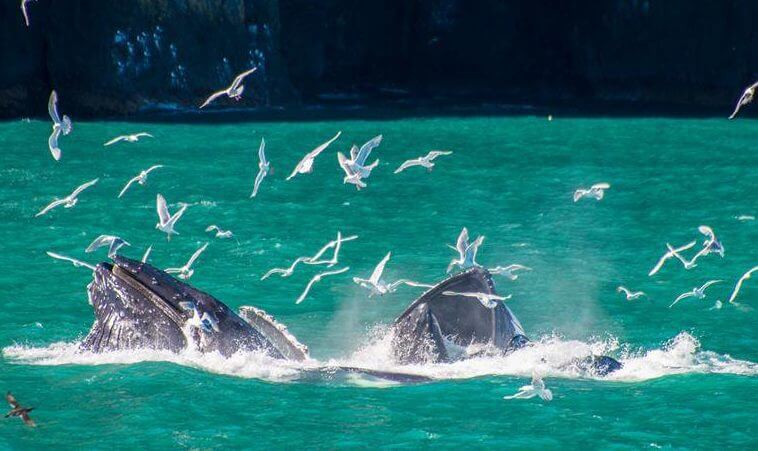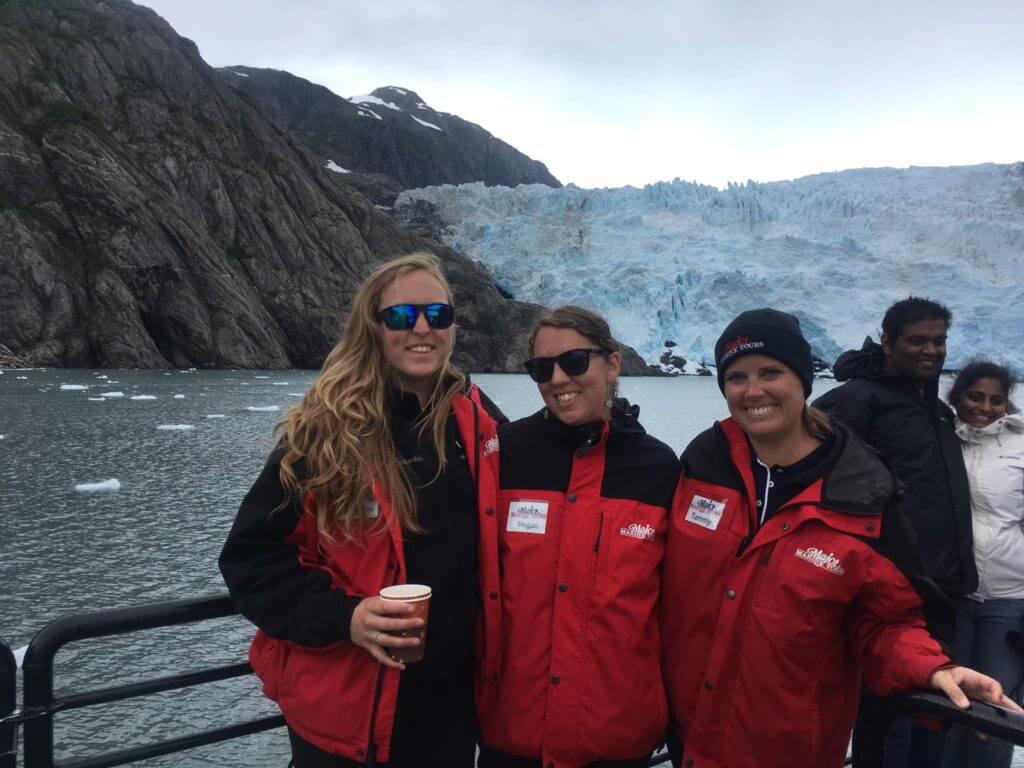Major Marine Tours deckhands get to view Alaska’s incredible wildlife and glaciers every day. After seeing whales breach, sea otters snuggle their pups, and glaciers calving so many times, does the novelty of this place ever wear off? Tamara Lang, Major Marine Tours deckhand and interpretive volunteer at Kenai Fjords National Park, reflects on the passion that she and her fellow deckhands have for the wildlife they see from Major Marine Tours cruises every day.
“The bar will be closed for the next ten minutes,” the speakers announced. “The crew will be outside viewing the wildlife, and we encourage you to do the same.” Sean put down the microphone and said to me, in a voice now natural, “get out there.”
The Glacier Express rocked slightly in the emerald green waters as Barwell Island rose behind our stern, but when I ran out onto the third deck nobody looked toward the island. All eyes on the boat were fastened toward the white kittiwakes suspended in wind in front of the cliffs, their eyes staring down their beaks into the water where, unseen, six adult humpback whales were weaving a round net of silver bubbles.

“Seeing bubble net feeding is incredibly special,” I whispered when the couple to my side asked what was happening. “This is the first I’ve seen it. Whales here have only begun using this behavior in the last few summers.”
They nodded, and I settled back into the watchful silence. A hush had settled over the boat. We were no longer a collection of colored coats and distant hometowns but a single entity, linked organically to the rounded still above the water where the whales would soon rise. The kittiwakes swung aimlessly in the wind. This was my favorite moment, before the solidity of sight, when the whales swam through our imagination instead of our vision. Somewhere below the water, six animals of long-finned grace and vast intelligence curled around a net made from their own breath, waiting below the trapped schools of fish for the call of one trumpeter who would tell them to when to surge, mouths open, up through the rippled underside of the sea.
Tension pulled taut as we mirrored their waiting from the other side of the surface, cameras at the ready. Kittiwakes roved the wind, aimlessly. Then in one instant every gull dropped from the sky and my eyes flashed along their path to the surface where a half-second later the humpbacks burst from the water, their ventral pleats ballooning at the surface. I had lost all weight and substance and become only a pair of eyes, rendered irrelevant by the mass of awe. The whales slid down, then breathed, and I sank back into my own body.
I looked to the wing station, where Captain John kept his camera trained on the whales. Sean kept his eyes on the water. Eric, my fellow deckhand, dropped his telephoto to give me a thumbs up. I knew Brett’s smile on the bow without seeing it. I could feel the tangible joy of the passengers around me, their faces lit up with the look that I love more than anything: wonder so real it comes mixed with watery surprise, lending dimension to the rich peace brought by wildness. A feeling savage and safe, capable of re-defining everything. I love nothing more than to see that feeling blossom on the faces of the passengers around me, because it is a feeling that I get to experience every day, and I know firsthand how that feeling can re-route your entire life.
I learned of whales for the first time in the form of dolphins nestled in the pages of books, read on the warm sand of my hometown of Long Beach, California as five-year-old me worked my way through 192 pages of a book with “dolphins” in the title. As part of a failed career path to become a seven-year-old SeaWorld trainer, I joined a club swim team that would instead bring me, ten years later, to the lifeguard tower where I sat with my eyes on the water for forty hours a week as I learned the poetry of waves and the habits of coastal bottlenose dolphins. “My job skills are not wearing shoes and finding dolphins,” I joked as I left college, and after two years of leaving my shoes at the door of my elementary school in South Korea, I thought I would put those dolphin-finding skills to use with a whale watch company in California while running a watershed education campaign and publishing a book about a bicycle trip up the Los Angeles River (Upstream, on Amazon, by the way). I grew tired of waiting for orca to pass through LA, though, and so I followed a conversation to Seward, Alaska to work for Major Marine Tours.
Once in Seward, I found the unbelievable richness of a biological community colored by the deep green of some of the most productive waters on earth. I also found another community just as inspiring: that of the crew that follows the whales. Crew like CJ, organizer extraordinaire, with whom I watched orca calves breach in silhouette against Bear Glacier. Or Brett, whom I found reading the book “Eye of the Whale” that had partially brought me to Alaska, and hence learned about his onboard research with gray whales off of Northern California. Eric Chandler, the colorblind photographer, and myself, the writer with anosmia, dropped a hydrophone into the water to listen to the orca with one of the few senses we both shared. Meggie can tell of researching sharks each midnight in Fiji and narrating whale watches in Tonga. And then, of course, there are those who follow the humpbacks to Hawaii, crew like Megan, Clint, and Kirsten. And these are only the deckhands; the captains have that many more years worth of stories.

As the Glacier Express sat above the feeding humpbacks I looked around me at the Spirit of Adventure and the Viewfinder — the Star of the Northwest and the Orca Song had already had their time with the whales — and I could not help but think about how full this water was of stories. These humpbacks had traveled to the Kenai Fjords from thousands of miles away for the rich food beneath the surface, and their presence had pulled us all to this green water from an even greater distance. Every person on the boat had a story of how they had come here, and I had this time onboard to learn those journeys. There was no more beautiful place to be, I thought, between the whales below and the sky above and the passengers new with awe, surrounded by the wonder of what was true. And I thought to myself how lucky I was to share those true moments, past and present, with every person that stood above the green water.
There is dimension here — Seward is not the same place that it was an hour ago. The stories onboard today will be newer than any that ever been heard or lived. So if you also happen to be out on the water today, do yourself a favor, and take the time between whales to share a story with the person in the red jacket.
Tamara Lang is a writer of creative nonfiction and a deckhand with Major Marine Tours in Seward, Alaska. Read more of her work at tamaralang.com, or follow her on facebook or instagram at @tamaralangwrites.
Signup for our newsletter to get the most recent Major Marine updates.